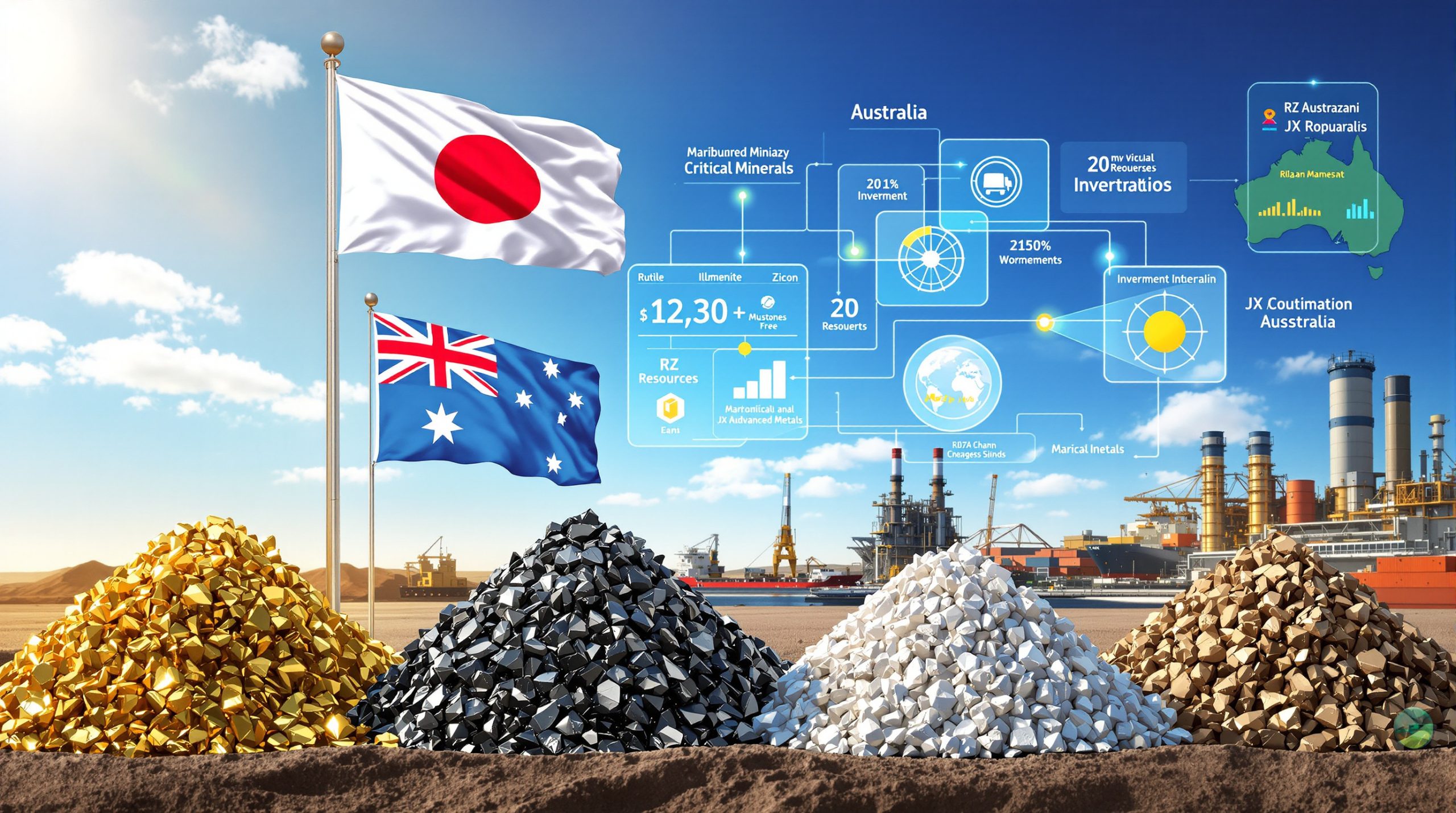Understanding China's Strategic Reversal in Trade Policy
China's recent decision to suspend export restrictions on three critical minerals to the United States represents a fundamental shift in global trade dynamics. This policy reversal affects gallium, germanium, and antimony – materials essential for advanced manufacturing across multiple industries. The China suspends ban on gallium, germanium, antimony exports to US decision marks a significant development in international trade relations.
The suspension, effective until November 27, 2026, marks a temporary de-escalation in ongoing trade tensions between the world's two largest economies. However, the underlying export control framework remains intact, requiring exporters to obtain licensing for overseas sales from China's Ministry of Commerce.
This strategic reversal followed a high-level diplomatic meeting between US President Donald Trump and Chinese President Xi Jinping in South Korea, demonstrating how critical minerals have become tools of economic statecraft. The timing suggests careful coordination between both nations to create negotiation space while maintaining underlying control mechanisms, particularly considering the broader implications of Trump tariff policies on international trade.
Which Critical Minerals Are Affected by the Policy Change?
Gallium – The Semiconductor Foundation
Gallium serves as a cornerstone material for modern electronics manufacturing, enabling production of high-frequency semiconductors for 5G networks, light-emitting diodes for energy-efficient lighting, photovoltaic cells for solar energy systems, and advanced radar and satellite communication systems.
Key Market Concentration:
- China controls approximately 94% of global gallium production according to European Union data from 2024
- Primary applications span consumer electronics to military technology
- Global demand continues rising with renewable energy expansion
This unprecedented supply concentration creates critical vulnerabilities for advanced technology sectors. Unlike distributed production models for other commodities, gallium's concentrated supply chain creates a critical choke point affecting simultaneously the semiconductor, renewable energy, and telecommunications industries.
Gallium's extraction occurs primarily as a byproduct of zinc mining and aluminium processing, requiring specialised refining facilities for electronics-grade purification. The limited number of global processors capable of meeting semiconductor specifications further constrains alternative supply development.
Multi-junction photovoltaic cells using gallium arsenide achieve over 40% efficiency in space applications and concentrated photovoltaic systems, compared to 22% efficiency for silicon cells. This efficiency differential drives sustained demand from aerospace and concentrated solar power projects, making supply disruptions particularly impactful for energy transition initiatives, especially in light of critical minerals and energy security concerns.
Germanium – The Fiber Optic Enabler
Germanium plays a crucial role in telecommunications and defence applications, including fiber-optic cable manufacturing for high-speed internet, infrared optical systems for night vision equipment, polyethylene terephthalate plastic production catalysts, and space-based solar cell technology.
Market Concentration Analysis:
| Production Metric | China's Share | Global Impact |
|---|---|---|
| Refined germanium | ~60% | Moderate supply control |
| Alternative sources | Limited but exist | Longer development timeline |
| Strategic importance | Defence/telecom focus | Substitution barriers exist |
Germanium's specialised optical properties create genuine substitution barriers in telecommunications and defence applications. Germanium dioxide serves as a core dopant in optical fibres, enabling long-distance telecommunications transmission critical for submarine cable systems connecting continents.
In infrared optical systems, germanium windows and lenses provide superior transparency in the 8-12 micrometer wavelength range for thermal imaging, night vision equipment, and military surveillance systems. Each transatlantic and transpacific fiber-optic cable project represents significant capital investment in germanium consumption, with supply disruptions directly impacting global connectivity infrastructure expansion.
Antimony – The Military Essential
Antimony's unique properties make it indispensable for defence and safety applications, including flame retardant compounds for textiles and plastics, ammunition primer manufacturing, lead-acid battery production enhancement, and specialised alloys for military equipment. Furthermore, strategic antimony insights reveal the growing importance of securing domestic sources.
Supply Chain Dynamics:
- China accounts for approximately 48% of global antimony mining
- Alternative sources exist but require significant development time
- Dual-use nature makes it strategically sensitive
Antimony's 48% market share represents China's weakest supply control position among the three metals. However, antimony's dual-use military applications and relatively small alternative production base create meaningful supply chain risks despite production diversification.
The challenge lies not in absolute supply scarcity but in rapid mobilisation of alternative production and the dual-use nature of production facilities. Antimony trioxide combined with halogenated compounds represents approximately 50% of global antimony consumption in flame retardant applications, creating cascading compliance issues across manufacturing chains during supply disruptions.
How Did Trade Tensions Escalate to Export Restrictions?
The timeline of restrictions reveals a pattern of escalating trade measures, with each step providing negotiation leverage while maintaining potential de-escalation pathways. Moreover, the Trump order on critical minerals has further influenced these dynamics:
August 2023: Initial export licensing requirements introduced on gallium and germanium
September 2024: Enhanced screening procedures implemented with stricter verification
December 2024: Complete export ban to US announced
November 2025: Suspension of ban declared
This escalation occurred alongside broader technology sector disputes, particularly concerning semiconductor manufacturing equipment and high-bandwidth memory chips. Each measure represented a response to corresponding US trade restrictions, following a principle of reciprocal trade pressure escalation.
China's escalation pattern demonstrated strategic calibration rather than impulsive response. The approximately 16-month escalation period reflected methodical policy development rather than reactive measures, suggesting careful assessment of US counterresponse capacity and economic impact calculations.
The licensing system created administrative burden and supply uncertainty without preventing all exports, while enhanced screening introduced longer processing timelines and increased documentation requirements. The complete ban eliminated licensing pathways entirely, creating immediate supply crises for US importers.
What Economic Impact Did the Export Ban Create?
US Industry Disruption
The export restrictions generated significant economic consequences, with the US Geological Survey estimating potential costs of $3.4 billion to the US economy. Semiconductor manufacturing experienced delays and increased costs, supply chain diversification efforts accelerated, and third-country routing arrangements developed.
Industry-Specific Impact:
- Semiconductor Manufacturing: Reduced production capacity for advanced chips and increased manufacturing costs
- Renewable Energy Sector: Solar panel manufacturers faced gallium supply constraints
- Defence and Aerospace: Military equipment procurement delays and satellite communication system development constraints
The ban created asymmetric economic impact where US industries dependent on these minerals faced immediate supply crises and cost escalation, while Chinese producers lost revenue but maintained broader market position.
Alternative Supply Development
US companies responded through multiple strategies during the ban period:
| Strategy | Implementation | Challenges | Cost Impact |
|---|---|---|---|
| Third-country sourcing | Routing through intermediary nations | Higher costs, complexity | 15-25% markup |
| Domestic production | Investment in US facilities | Long development timelines | 3-5 years to market |
| Recycling programmes | Enhanced material recovery | Limited scale initially | Moderate |
| Strategic reserves | Government stockpiling | Significant capital requirements | High upfront |
Companies implemented inventory depletion strategies, accelerated use of existing stocks, and temporary cost absorption by manufacturers. Third-country routing through Singapore, Hong Kong, and Malaysia added logistics costs while creating compliance and verification challenges for end-users.
Why Did China Suspend the Export Ban Now?
Diplomatic Considerations
Recent high-level diplomatic engagement between US and Chinese leadership created opportunities for trade policy adjustments. The suspension demonstrates willingness to de-escalate trade tensions, recognition of mutual economic interdependence, and strategic timing aligned with broader diplomatic initiatives.
The suspension announcement following the Trump-Xi meeting in South Korea suggests coordination on broader trade negotiation frameworks beyond these three minerals, potentially affecting semiconductor trade, agricultural exports, and technology sector agreements.
Economic Pragmatism
China's decision reflects several economic realities:
- Revenue preservation from valuable export markets
- Industry stability for Chinese producers
- Global supply chain maintenance considerations
- Competitive positioning against alternative suppliers
By maintaining export controls on China's dual-use item list while suspending the outright ban, China preserves long-term leverage while demonstrating diplomatic flexibility to facilitate broader trade negotiations.
What Restrictions Remain in Place?
Licensing Requirements
Despite the suspension, significant controls persist. All exports still require government approval through dual-use item control lists, individual export license applications, end-user verification procedures, and regular compliance monitoring from China's Ministry of Commerce.
The metals remain on China's dual-use export control list, meaning exporters must still apply for licenses for any overseas sales. This licensing system maintains China's regulatory authority over future exports while allowing resumed trade flows.
Military User Prohibitions
Complete restrictions continue for US Department of Defense contractors, military research institutions, defence-related end applications, and dual-use technology developers. These measures, introduced in December 2024, continue unchanged despite the general suspension.
Exporters continue facing restrictions when dealing with customers identified as military users in the US, maintaining strategic control over defence-related applications while permitting commercial trade resumption.
How Will This Affect Global Supply Chains?
Immediate Market Stabilisation
The suspension provides short-term relief through price volatility reduction in affected materials, supply certainty for US manufacturers, investment confidence restoration in dependent industries, and strategic planning timeline extension.
US chipmakers producing high-frequency components for 5G infrastructure, who faced production constraints immediately upon ban implementation, can now resume normal procurement processes. Companies without existing reserves or alternative suppliers experienced production delays of 3-6 months during the ban period.
Additionally, the development of an European CRM facility represents part of the broader effort to diversify critical mineral supply chains globally.
Long-term Diversification Trends
Despite the suspension, structural changes continue with supply source diversification including Australian gallium production expansion, Canadian germanium project development, Bolivian antimony mining growth, and European recycling capacity building.
Technology Innovation Acceleration:
- Material substitution research advancement
- Recycling efficiency improvements
- Alternative processing methods development
- Strategic stockpiling programmes expansion
The temporary nature of the suspension highlights continuing risks, suggesting that future restrictions could be reimposed based on geopolitical developments. Organisations are implementing comprehensive risk management approaches including multiple supplier relationships development and geographic diversification of sourcing.
What Does This Mean for Future Trade Relations?
Precedent for Negotiated Solutions
This suspension establishes a framework for addressing trade disputes through temporary measures allowing negotiation space, graduated responses rather than permanent restrictions, economic pragmatism balancing political objectives, and multilateral implications affecting global trade patterns.
China's approach demonstrates how critical minerals can serve as diplomatic tools, creating leverage through supply control while facilitating negotiation through temporary measures and integrating economic statecraft with foreign policy.
Ongoing Vulnerability Assessment
The temporary nature highlights continuing risks where underlying control mechanisms remain intact. Future restrictions could be reimposed based on geopolitical developments, making continued vigilance essential for supply chain planning.
Critical Insight: While the suspension provides immediate relief, the underlying control mechanisms remain intact, suggesting that future restrictions could be reimposed based on geopolitical developments.
Which Industries Benefit Most from the Suspension?
Semiconductor Manufacturing
The electronics sector gains significant advantages through production planning certainty for chip manufacturers, cost stability for high-tech components, innovation continuity in advanced applications, and supply chain optimisation opportunities.
Gallium arsenide semiconductors essential for 5G radio frequency components can resume normal production scheduling, with superior performance at high frequencies compared to silicon alternatives maintaining their market position.
Renewable Energy Sector
Clean energy industries benefit through solar panel production cost reduction, LED lighting manufacturing stability, energy storage system development support, and grid infrastructure modernisation advancement.
The efficiency advantages of gallium-based multi-junction photovoltaic cells in concentrated solar power projects can continue driving sustainable demand from renewable energy installations.
Defence and Aerospace
Military applications gain improved access to advanced radar system components, satellite communication materials, night vision equipment supplies, and specialised alloy production inputs.
Space-based solar cell technology relying on germanium as substrate and cell component can resume normal procurement for NASA and aerospace programmes requiring superior radiation resistance for space applications.
How Should Companies Prepare for Potential Future Changes?
Risk Management Strategies
Organisations should implement comprehensive approaches including supply chain resilience through multiple supplier relationships development, geographic diversification of sourcing, strategic inventory management, and alternative material research investment.
Regulatory Compliance Enhancement:
- Enhanced licensing procedure understanding
- Legal counsel engagement for trade matters
- Documentation system improvements
- Regular policy monitoring implementation
Investment Considerations
Forward-looking strategies require careful timeline and risk assessment:
| Investment Area | Timeline | Risk Level | Potential Return | Strategic Value |
|---|---|---|---|---|
| Alternative suppliers | 1-3 years | Medium | Moderate | Supply diversification |
| Recycling technology | 3-5 years | High | High | Sustainable sourcing |
| Domestic production | 5-10 years | High | Very High | Supply independence |
| Strategic partnerships | 1-2 years | Low | Moderate | Risk mitigation |
Companies should balance immediate supply security needs with long-term strategic positioning, recognising that the temporary suspension provides planning time rather than permanent supply security.
What Global Implications Emerge from This Decision?
Precedent for Resource Diplomacy
China's approach demonstrates how critical minerals serve as diplomatic tools through leverage creation via supply control, negotiation facilitation through temporary measures, economic statecraft integration with foreign policy, and multilateral impact on global trade relationships.
The graduated escalation and suspension pattern provides a template for resource-rich nations to exercise economic influence while maintaining diplomatic flexibility for future negotiations.
Acceleration of Supply Security Initiatives
Other nations are likely to accelerate their own programmes including strategic reserve building for critical materials, domestic production incentives through policy support, international cooperation on supply chain resilience, and technology development for material alternatives.
The vulnerability exposed by China's export controls has catalysed global recognition of critical mineral dependency risks, driving investment in alternative production capacity and supply chain diversification across multiple nations and industries.
Strategic Reserve Development:
- Enhanced national stockpiling programmes
- Public-private partnership frameworks
- International cooperation agreements
- Technology sharing initiatives for alternative materials
This suspension of China suspends ban on gallium, germanium, antimony exports to US represents a significant development in critical minerals trade, providing immediate relief while highlighting the ongoing need for supply chain resilience planning. The temporary nature of the suspension emphasises that companies and nations must continue developing alternative supply sources and strategic reserves to manage future geopolitical risks in critical material markets.
The precedent established through this graduated approach to trade policy – from licensing to enhanced screening to complete ban to conditional suspension – demonstrates how critical minerals have become tools of economic statecraft in the modern global economy. According to CNBC's analysis, the suspension comes as a trade truce takes hold between the two nations. Furthermore, as reported by Mining Technology, understanding these dynamics remains essential for strategic planning across industries dependent on these vital materials.
Ready to Capitalise on Critical Mineral Investment Opportunities?
Discovery Alert's proprietary Discovery IQ model delivers real-time alerts on significant ASX mineral discoveries, including critical materials like gallium, germanium, and antimony that are reshaping global supply chains. With China's export restrictions highlighting the strategic value of these minerals, now is the crucial time to position yourself ahead of the market and identify actionable opportunities before they become mainstream news.




